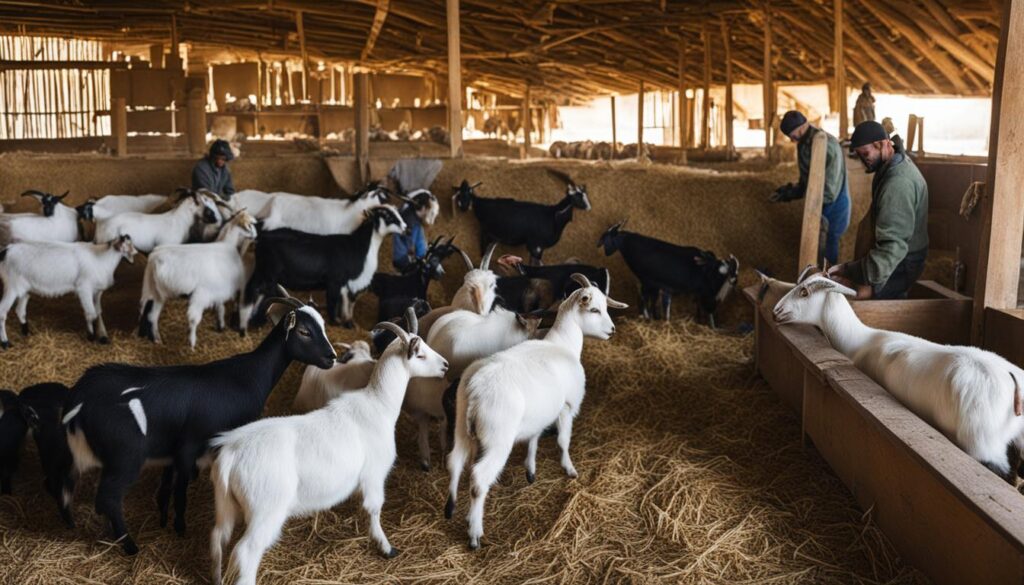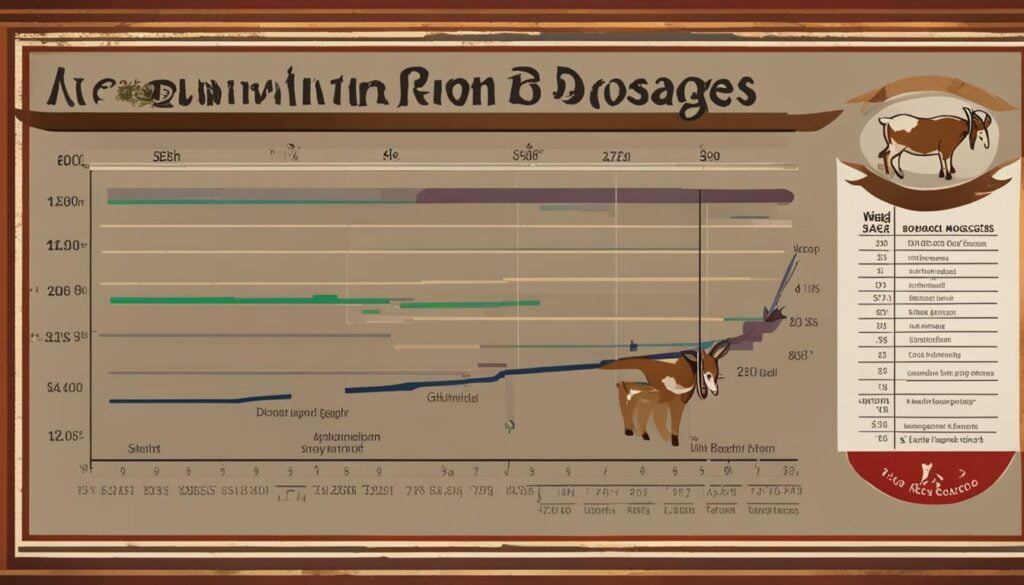As a dedicated hobby farmer, I’ve come to understand that maintaining goat health requires a holistic approach, with one crucial aspect often going unnoticed – iron supplementation. Recognizing iron deficiency in goats and addressing it with an efficacious iron supplement for goats can mean the difference between a thriving herd and one that’s frustratingly lethargic. Through years of experience, I’ve embraced the use of injectable iron as a potent solution for preventing anemia and bolstering the well-being of my goats. Here, I’ll share insights into the dosing specifics that will aid my fellow backyard goat-enthusiasts in ensuring their beloved animals are not just surviving, but flourishing.
Key Takeaways
- Identifying iron deficiency symptoms in your goats is critical for timely intervention.
- Injectable iron is an effective method for quickly rectifying iron levels.
- Understanding your goats’ unique health needs is essential for administering the correct dosage of iron.
- A hands-on guide for the safe delivery of injectable iron can aid in preventing potential complications.
- Regular consultation with a veterinarian is pivotal in maintaining goat health and managing their iron requirements effectively.
- Familiarizing yourself with the post-injection care is beneficial for monitoring the health of your goats.
Understanding the Need for Iron in Goats
As a keen observer of my goat herd’s health, I’ve come to understand how iron plays a pivotal role in their overall well-being. In my duties as a hobby farmer, addressing the iron needs of my goats is as critical as providing them with shelter and food. An iron-rich diet is fundamental to preventing anemia in goats and promoting their vigorous growth and development.
Signs of Iron Deficiency in Goats
Identifying goat anemia symptoms can be the first step to ensuring the health of your herd. Common signs include:
- Lethargy and reduced activity levels
- Pale mucous membranes, notably the gums and eyelids
- Weakness and a noticeable decline in appetite
These symptoms indicate that it might be time to assess and address the iron levels in your goats’ diet.
How Iron Supports Goat Health
The benefits of iron for goats cannot be overstated. Iron is a critical mineral that is involved in multiple bodily functions, particularly:
- The production of hemoglobin, essential for oxygen transport
- Supporting a healthy immune system
- Facilitating energy metabolism
Ensuring your goats receive the right amount of iron is a surefire way to foster optimal growth and vitality.
Risks Related to Low Iron Levels
An iron-deficient diet poses significant risks to a goat’s health. The most concerning include:
| Condition | Consequences |
|---|---|
| Anemia | Decreased oxygenation leading to organ failure |
| Weak Immune Function | Increased susceptibility to infections and diseases |
| Poor Growth | Stunted development and reduced productivity |
By investing in preventative measures and understanding the vital role of iron, we can safeguard our goats from such detrimental outcomes.
The Role of Injectable Iron for Goats Dosage
As a hands-on farmer managing my own herd, I’ve grown increasingly appreciative of the swift efficacy of injectable iron for newborn goats. Newborns, with their fragile state and the high iron demand of their rapid growth, often fall victim to deficiency without swift intervention. In my practice, I’ve utilized iron injections to overcome the limitations provided by oral supplementation, noting substantial improvements in the liveliness and health of my young goats.

The direct administration of iron via injection ensures that my herd absorbs the necessary minerals without the complexities of dietary variables. The injectable iron benefits are multifaceted, encompassing not just a prevention strategy against anemia but also a promoter of robust growth and vigor within the herd.
- Quick Correction of Iron Levels
- Targeted Treatment for At-Risk Newborns
- Enhanced Growth and Development
Administering the correct iron dosage administration is pivotal. Over the years, I have streamlined a dosage schedule that maximizes benefit while minimizing risk, tailored specifically to the needs of my goats—newborns, growing kids, and pregnant does alike.
| Goat Category | Iron Dosage (per administration) | Recommended Frequency |
|---|---|---|
| Newborn Kids | 1-2 mL | Within first 24-48 hours, repeat at 4-6 weeks if necessary |
| Growing Kids | 2-4 mL | Every 4-6 weeks |
| Pregnant Does | 4-6 mL | Pre-birthing and postpartum as needed |
Starting with the fragile first days of life, an iron injection for newborn goats can set the foundation for a life of vitality. Injectable iron benefits the herd not only by preventing iron deficiency anemia but also by stimulating a strong start—critical for the demanding life ahead of them. Indeed, in my years of raising goats, I’ve found that the wise and well-researched administration of iron injections has been instrumental in sustaining a vibrant and healthy goat population on my farm.
Assessing Your Goats’ Iron Requirements
Ensuring my goats receive the proper amount of iron in their diet is a puzzle I’m committed to solving. Each goat in my herd is an individual with unique dietary needs. Their health and vitality depend on a delicate balance of nutrients, including iron. Understanding and catering to their individual iron requirements not only supports their growth and productivity but also fortifies their overall well-being.
Factors That Affect Iron Needs in Goats
Several variables contribute to the quantity of iron required by each goat. Age is a decisive factor; I’ve observed that my younger kids and lactating does have a heightened need for iron. Their diet also plays a crucial role, and goat dietary needs must include an appropriate balance of minerals and vitamins. Furthermore, the breed can determine predisposition to certain conditions, including anemia, and general health status may increase the necessity for this mineral. Ensuring my goats’ eating regimen is rich in iron-rich forages and considering supplemental feeds is part of my commitment to responsible husbandry.

When to Consult a Veterinarian
While my experience serves as a guide, there’s no substitute for professional veterinary guidance for goats, especially when faced with signs of iron deficiency or establishing a new supplementation routine. I always recommend consulting with a vet to secure an accurate assessment and appropriate iron supplementation strategy. A veterinarian can provide invaluable insights into the individual iron requirements unique to each goat, backed by science and tailored to my herd’s specific needs.
Through vigilant observation and responsible management, including leveraging expert advice, I can provide each of my goats with the iron necessary to maintain their health and productivity. After all, their well-being is the cornerstone of a thriving and happy herd.
Safe Administration of Injectable Iron for Goats Dosage
Ensuring the health and vitality of a goat herd involves many precise practices, one of which is the safe administration of injectable iron. Done correctly, this procedure can significantly enhance the animals’ well-being. I’d like to share the meticulous steps I take to prepare and execute this task, drawing on my personal experiences to empower fellow hobby farmers with knowledge and confidence.
Preparing for the Injection
My first step is always to prepare for the injectable iron dosing procedure meticulously. I make certain that the injection site on the goat is clean, which means shaving the area if necessary and disinfecting it thoroughly. All syringes and vials are handled with utmost care to maintain sterility. Equally important is confirming the iron dosage based on the goat’s specific needs to avoid underdosing or overdosing. This preparation sets the stage for a safe and efficient treatment.
Best Practices for Injectable Iron Administration
I adhere steadfastly to best practices for safe goat treatments which involve using the right technique for intramuscular injections. A steady hand and a calm demeanor ensure the goat is at ease during the process. I gently but firmly administer the iron at the prescribed site, usually in the muscle, where it can be quickly assimilated into the bloodstream. Following the injection, I apply slight pressure to the site to prevent bleeding and promote closure of the puncture.
Monitoring Goats Post-Injection
After the injection, diligent post-injection care in goats is vital. It’s paramount to observe the animal for any immediate reactions or signs of distress. I monitor their appetite, activity level, and the injection site for signs of swelling or infection over the next several days. Timely intervention in case of adverse effects is the key to preventing complications and generally involves contacting a veterinarian if anything seems amiss. In all, these measures contribute significantly to the well-being of my goats and the overall health of my herd.
